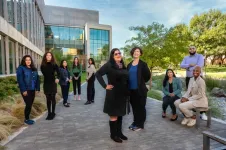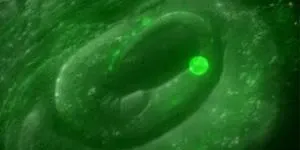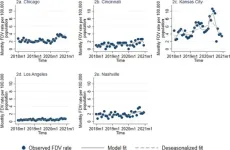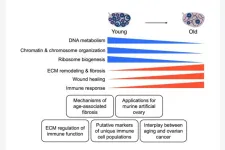(Press-News.org) UTA will soon add a new piece of cutting-edge equipment to its already impressive and growing research armamentarium—a type of super-resolution microscope (SRM) that allows biologists to see structures within a cell in even finer detail.
The SRM will come to UTA because of additional grant funding from the National Institutes of Health (NIH) to the lab of Piya Ghose, an assistant professor of biology at UTA. This nearly $250,000 award supplements Ghose’s existing NIH/National Institute of General Medical Sciences (NIGMS) Maximizing Investigators’ Research Award/Outstanding Investigator Award.
“We are really excited to bring this advanced imaging technology to our lab and UTA,” Ghose said. “We believe this will strongly position us to make important discoveries in the field of cell death and cell biology in general. My team and I are extremely excited to start imaging at this level.”
The Ghose lab studies the intricacies of programmed cell death—the genetically controlled end of life of most cells. This programmed cell death sculpts and refines tissues, ultimately removing cells the organism no longer needs or wants.
Researchers in Ghose’s lab are interested in how the general shape of a cell and the structures within it influence how the cell dies. Many cells have highly complicated structures, such as nerve cells that span long distances, with regions that are vastly different from each other. In addition to the surrounding environment of these regions being different, the internal architecture of each region of the cell is different.
The Ghose lab studies programmed cell death in a tiny embryonic cell of the roundworm C. elegans, which as a full-grown adult is 1 millimeter in length, about the size of the tip of a sharpened pencil or a sewing needle. This tiny cell is in the tail of the roundworm’s embryo and dies before the animal can hatch. Since it has a complicated structure like a nerve cell, it is ideal for studying cell death.
The Ghose lab is interested in the structures within the cell called organelles or “little organs,” such as mitochondria (which produce energy) and the endoplasmic reticulum (which help make proteins, among other functions). \ Since one of the lab’s important research goals is to better understand how these tiny organelles within a tiny cell of a tiny animal affect cell death, they believe employing the new SRM technology will allow them to pinpoint and document cell death in even finer detail.
“Having this state-of-the-art research equipment here on our campus is very exciting,” said Karen Juanez, a member of the Ghose lab who herself won a NIGMS award in 2022. “It pushes UTA further toward research excellence and continues to facilitate ground-breaking research. It feels awesome to be able to tackle and address interesting questions about cells and what goes on in them at a super zoomed-in scale.”
END
NIH funding helps Ghose Lab invest in innovative imaging equipment
Super-resolution microscopy allows finely detailed observation of living subcellular structures
2023-11-01
ELSE PRESS RELEASES FROM THIS DATE:
Domestic violence involving firearms increased during COVID-19 pandemic
2023-11-01
(SACRAMENTO, Calif.) — Domestic violence went down or stayed the same during the first 10 months of the COVID-19 pandemic in five major U.S. cities. However, domestic violence involving firearms increased in three of those cities, according to a new UC Davis study published in the Journal of Family Violence.
“The increase in firearm domestic violence is concerning, as abuser firearm access is a risk factor for lethality,” said Elizabeth Tomsich, a research data analyst at the UC Davis Violence Prevention Research Center and ...
Microbiology: River plastics may harbour potential pathogens and antimicrobial resistance genes
2023-11-01
Microbial communities growing on plastic debris in rivers may have the capacity to harbour potentially pathogenic microbes and act as reservoirs of antimicrobial resistance genes, according to a study published in Microbiome. The findings also highlight differences in the potential pathogens and antimicrobial resistance genes that new and degraded plastics may have the capacity to harbour.
Vinko Zadjelovic, Elizabeth Wellington, Joseph Christie-Oleza and colleagues characterised the microbial communities found on the surface ...
High metabolism is an early sign of Alzheimer’s disease
2023-11-01
An early phase in the process of developing Alzheimer’s disease is a metabolic increase in a part of the brain called the hippocampus, report researchers from Karolinska Institutet in a study published in Molecular Psychiatry. The discovery opens up for new potential methods of early intervention.
Alzheimer’s disease is the most common form of dementia and strikes about 20,000 people in Sweden every year. Researchers now show that a metabolic increase in the mitochondria, the cellular power ...
Trust is the most important factor for British South Asians when taking part in genetic research to tailor medications
2023-11-01
Researchers from Queen Mary University of London have gathered detailed insights from the British South Asian community that could lead to more successful implementation of genetic testing to help tailor the use of routine medications. Their findings are published today (1 November 2023) in The Pharmacogenomics Journal and indicate key issues that could affect the take up of this new type of genetic testing amongst patients.
Despite comprising 10% of the British population, individuals of South Asian heritage have historically been under-represented in ...
Cigarette style warning labels could reduce people’s meat consumption
2023-11-01
Cigarette style graphic warning labels could reduce people’s meat consumption, according to new research published today (1 November).
The study suggests the use of warning labels on meat options could improve public health and reduce the UK’s carbon footprint.
The team from Durham University tested a range of warning labels including those which warn people of the damage to climate, health, and risk of pandemics. They found that all labels were effective at discouraging people from choosing meals with meat.
All warning labels, which showed ...
New research finds that nature-based solutions are essential for Brazil to meet its 2050 net zero pledge
2023-11-01
A new study has concluded that any credible net zero pathway for Brazil must include the implementation of nature-based solutions.
Actions such as halting deforestation and large-scale restoration of native vegetation would have immediate impact, at a fraction of the cost of carbon-negative technologies.
However, stronger policy frameworks will be needed if nature-based solutions are to achieve their full potential in Brazil.
Without the implementation of nature-based solutions, in particular ending deforestation and restoring ...
New position statement supports permanent standard time
2023-10-31
DARIEN, IL – An updated position statement from the American Academy of Sleep Medicine supports the replacement of daylight saving time with permanent standard time.
It is the position of the AASM that the United States should eliminate seasonal time changes in favor of permanent standard time, which aligns best with human circadian biology. According to the statement, evidence supports the distinct benefits of standard time for health and safety, while also underscoring the potential harms that result from seasonal time changes to and from daylight saving time.
“By causing the human body ...
Reverse engineering Jackson Pollock
2023-10-31
Can a machine be trained to paint like Jackson Pollock? More specifically, can 3D-printing harness the Pollock's distinctive techniques to quickly and accurately print complex shapes?
“I wanted to know, can one replicate Jackson Pollock, and reverse engineer what he did,” said L. Mahadevan, the Lola England de Valpine Professor of Applied Mathematics at the Harvard John A. Paulson School of Engineering and Applied Sciences (SEAS), and Professor of Organismic and Evolutionary Biology, and of Physics in the Faculty of Arts and Sciences (FAS).
Mahadevan and his team combined physics and machine learning to develop a new 3D-printing ...
Proteomic quantification of native and ECM-enriched mouse ovaries reveals an age-dependent fibro-inflammatory signature
2023-10-31
“Overall, our study provides novel insight into how reproductive aging impacts the murine ovarian proteome and ECM.”
BUFFALO, NY- October 31, 2023 – A new priority research paper was published on the cover of Aging (listed by MEDLINE/PubMed as "Aging (Albany NY)" and "Aging-US" by Web of Science) Volume 15, Issue 20, entitled, “Proteomic quantification of native and ECM-enriched mouse ovaries reveals an age-dependent fibro-inflammatory signature.”
The ovarian microenvironment becomes fibrotic and stiff with age, in part due to increased collagen and decreased hyaluronan. However, the extracellular matrix ...
Hix, Lajoie elected Fellows of the American Physical Society
2023-10-31
Physicists William Raphael “Raph” Hix of the Department of Energy’s Oak Ridge National Laboratory and John Lajoie, who will join ORNL on Nov. 6 from Iowa State University, have been elected Fellows of the American Physical Society.
The society works to advance and spread physics knowledge via research journals, scientific meetings, education, outreach, advocacy and international activities. It represents more than 50,000 members, including physicists in government, academia and industry worldwide.
Hix, leader of the Theoretical and Computational ...
LAST 30 PRESS RELEASES:
Making lighter work of calculating fluid and heat flow
Normalizing blood sugar can halve heart attack risk
Lowering blood sugar cuts heart attack risk in people with prediabetes
Study links genetic variants to risk of blinding eye disease in premature infants
Non-opioid ‘pain sponge’ therapy halts cartilage degeneration and relieves chronic pain
AI can pick up cultural values by mimicking how kids learn
China’s ecological redlines offer fast track to 30 x 30 global conservation goal
Invisible indoor threats: emerging household contaminants and their growing risks to human health
Adding antibody treatment to chemo boosts outcomes for children with rare cancer
Germline pathogenic variants among women without a history of breast cancer
Tanning beds triple melanoma risk, potentially causing broad DNA damage
Unique bond identified as key to viral infection speed
Indoor tanning makes youthful skin much older on a genetic level
Mouse model sheds new light on the causes and potential solutions to human GI problems linked to muscular dystrophy
The Journal of Nuclear Medicine ahead-of-print tip sheet: December 12, 2025
Smarter tools for peering into the microscopic world
Applications open for funding to conduct research in the Kinsey Institute archives
Global measure underestimates the severity of food insecurity
Child survivors of critical illness are missing out on timely follow up care
Risk-based vs annual breast cancer screening / the WISDOM randomized clinical trial
University of Toronto launches Electric Vehicle Innovation Ontario to accelerate advanced EV technologies and build Canada’s innovation advantage
Early relapse predicts poor outcomes in aggressive blood cancer
American College of Lifestyle Medicine applauds two CMS models aligned with lifestyle medicine practice and reimbursement
Clinical trial finds cannabis use not a barrier to quitting nicotine vaping
Supplemental nutrition assistance program policies and food insecurity
Switching immune cells to “night mode” could limit damage after a heart attack, study suggests
URI-based Global RIghts Project report spotlights continued troubling trends in worldwide inhumane treatment
Neutrophils are less aggressive at night, explaining why nighttime heart attacks cause less damage than daytime events
Menopausal hormone therapy may not pose breast cancer risk for women with BRCA mutations
Mobile health tool may improve quality of life for adolescent and young adult breast cancer survivors
[Press-News.org] NIH funding helps Ghose Lab invest in innovative imaging equipmentSuper-resolution microscopy allows finely detailed observation of living subcellular structures






